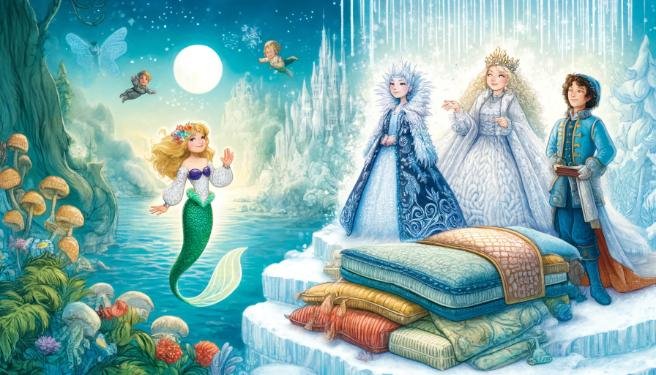Step into the bewitching realm of Hans Christian Andersen fairy tales, a world where mermaids dwell deep in the ocean’s embrace, and ugly ducklings emerge as swans. Andersen’s stories continue to captivate the hearts of children and adults alike, transcending time and culture.
Renowned for his literary genius, Hans Christian Andersen crafted narratives that reflect the complexities of life and emotion, all while enchanting his readers with spellbinding worlds of fantasy and moral lessons. His tales have been a staple in the world of children’s literature and continue to inspire countless new stories and adaptations.
Who was Hans Christian Andersen?
Hans Christian Andersen was not only a master storyteller but also a prolific Danish author whose life’s journey from poverty to fame is as compelling as his timeless tales. Born in 1805, Andersen’s passion for storytelling was evident from a young age, and he eventually became one of the most influential fairy tale writers in history.
Despite facing numerous challenges, including societal prejudices and personal hardships, Andersen’s imagination never dimmed. His ability to turn personal struggles into creative fuel resulted in some of the most beloved and enduring stories in children’s literature.
Andersen’s legacy is built upon his remarkable talent for weaving tales that captured the imagination of readers around the world, making him a legendary figure in the realm of literary folklore.
What are the most famous Hans Christian Andersen stories?
- The Little Mermaid: A poignant tale of a mermaid willing to give up her life in the sea for a chance at human love and an immortal soul.
- The Ugly Duckling: A story of transformation and self-realization, where an unremarkable birdling grows into a majestic swan.
- The Princess and the Pea: The story of a prince’s search for a true princess is a testament to Andersen’s wit and love for the unexpected.
- The Snow Queen: A gripping narrative of friendship and adventure set against the backdrop of a frozen landscape.
- The Emperor’s New Clothes: A humorous and satirical story highlighting the follies of vanity and pride.
These tales have left an indelible mark on the fabric of fairy tales, being passed down through generations and across cultures, each adaptation adding its own local flavor to the universal themes found within Andersen’s original works.
How have Andersen’s fairy tales influenced modern literature?
The echoes of Hans Christian Andersen’s fairy tales can be heard throughout modern literature. His influence extends beyond the boundaries of children’s stories, inspiring novelists, poets, and playwrights with his themes of transformation, resilience, and the stark realities of human nature.
Andersen’s talent for blending the fantastical with the authentic has paved the way for a diversity of genres, from fantasy to realism. His stories are known for their depth, often reflecting societal issues and personal dilemmas that resonate to this day.
Many contemporary authors cite Andersen as an inspiration, emulating his ability to touch the hearts of readers with simple yet profound storytelling. The enduring legacy of Andersen’s fairy tales continues to shape the world of literature, reminding us of the power of a well-told story.
Where can you find the best illustrated editions of Andersen’s tales?
Illustrations play a vital role in bringing Hans Christian Andersen fairy tales to life. The visual portrayal of Andersen’s characters and scenes has captured the imagination of countless readers, with illustrators adding their own artistic interpretations to these classic stories.
The best-illustrated editions can often be found in bookstores, libraries, and online collections. Renowned artists such as Edmund Dulac, Arthur Rackham, and Lisbeth Zwerger have all contributed to the rich visual history of Andersen’s tales, their artwork complementing the text and enhancing the reader’s experience.
For those seeking to collect or simply enjoy these illustrated editions, it is recommended to look for publications that honor the integrity of Andersen’s work while showcasing the unique style of the illustrator. These editions not only serve as a gateway to Andersen’s world but also as a testament to the interplay between text and art in storytelling.
What was the impact of Andersen’s travels on his storytelling?
Hans Christian Andersen’s extensive travels played a significant role in shaping his narratives, allowing him to draw upon a wealth of cultural experiences and landscapes. His journeys across Europe and beyond enriched his imagination, providing new settings, characters, and themes for his tales.
The diversity of Andersen’s experiences is evident in the varied backdrops and universal themes present in his work. His ability to transcend cultural barriers with relatable stories of love, loss, courage, and redemption speaks to the impact his travels had on his creative process.
Andersen’s observant nature and curiosity about the world are reflected in the vivid descriptions and emotional depth of his fairy tales, making them a mosaic of his life’s adventures and encounters.
How did Hans Christian Andersen’s personal life affect his works?
Hans Christian Andersen’s personal life, marked by emotional struggles and a quest for acceptance, profoundly influenced his stories. Aspects of his own experiences, including his feelings of isolation and his unrequited loves, often found their way into his fairy tales, imbuing them with authenticity and poignancy.
Andersen’s complex relationship with his own identity and place in society can be seen in the recurring themes of transformation and self-discovery in his work. His tales often feature characters that must overcome adversity or learn important life lessons, a reflection of Andersen’s own journey through life.
The depth of Andersen’s characters, the moral intricacies, and the blend of darkness and light in his stories are testament to the impact of his personal experiences on his work. It is this intricate weaving of Andersen’s own life with the fables he created that continues to resonate with readers and solidify his place in the annals of literary history.
Diving deeper into Andersen’s stories
For those enchanted by the timeless allure of Hans Christian Andersen fairy tales, there is a wealth of knowledge to explore. Scholars and enthusiasts alike have delved into the layers of meaning within Andersen’s work, uncovering the historical context, psychological depth, and artistic brilliance that define his stories.
Recommendations for further reading and study include biographies that chronicle Andersen’s life and times, critical analyses that examine the thematic elements of his work, and comparative studies that highlight his impact on both his contemporaries and modern authors.
By embracing the legacy of Hans Christian Andersen, readers of all ages can continue to discover the magic and wisdom woven into the tapestry of his fairy tales, a legacy that endures as a cornerstone of children’s literature and storytelling art.


Leave a Reply